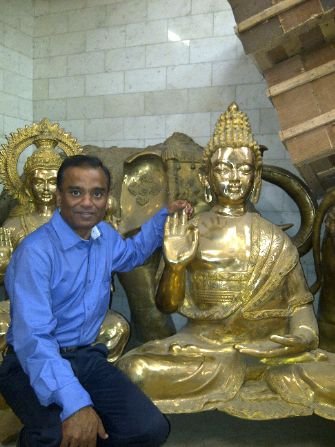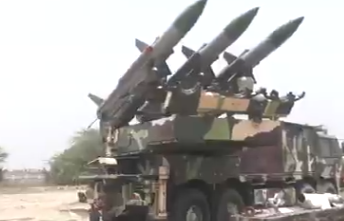Thwarting Terror: The Failed Attack on Amritsar's Golden Temple
-
 N Chandra
N Chandra
| Monday 19th of May 2025 01:14:00 PM (UTC)
- Category: News

A carefully orchestrated large-scale assault by Pakistan on the esteemed Golden Temple in Amritsar was successfully averted by the Indian armed forces. This incident, embedded into a broader confrontation characterised by artillery, drone, and missile engagements across border territories, has emerged following an official exhibition and numerous declarations from senior military and governmental representatives.
India's successful threat interception resulted from high preparedness, precise intelligence, and the effective deployment of modern air defence systems. The foiled assault by Pakistan included both direct military aggression and strategic psychological tactics, aiming to target religious institutions across various regions to incite communal discord.
Why Pakistan Targeted the Golden Temple
As tensions intensified along the Line of Control (LoC) and the international border in early May, Indian intelligence agencies acquired intelligence suggesting that Pakistani forces, facing challenges in discerning legitimate military targets, were poised to target religious and civilian installations within India. Notably, one of the principal sites highlighted in these intelligence assessments was the Golden Temple in Amritsar, a revered sanctuary in Sikhism.
Major General Kartik C. Seshadri, the General Officer Commanding (GOC) of the 15th Infantry Division, disclosed that Pakistan aimed to inflict both symbolic and psychological damage by launching attacks on high-profile civilian and religious sites. Anticipating that the Pakistani Army would resort to targeting Indian military and civilian installations, including religious places, the Indian forces mobilised additional modern air defence assets to provide comprehensive air defence coverage for the Golden Temple.
In the early hours of May 8, Pakistan executed an aerial offensive using long-range missiles and drone platforms. According to Seshadri, this “massive air assault” took place during the darkness of night, focusing on civilian populations and sensitive locations, with the Golden Temple at the top of the target list. “We were fully prepared since we had anticipated this. Our brave and alert army air defence personnel thwarted the Pakistan Army’s nefarious designs and shot down all drones and missiles aimed at the Golden Temple, ensuring that not a single scratch touched our holy site,” he stated.
How the Golden Temple Attack Was Foiled
In the aftermath of the failed assault, the Indian Army conducted a detailed demonstration showcasing how its air defence systems neutralised the aerial threats. The indigenous AKASH missile platform and the L-70 Air Defence Guns played central roles in intercepting incoming drones and missiles over Amritsar and other areas in Punjab. The demonstration illustrated these systems' ability to detect, track, and engage aerial targets with high precision under operational conditions. The coordinated response protected the Golden Temple and shielded other parts of Punjab from potential destruction.
The Indian Air Defence Forces successfully destroyed all hostile projectiles before they could inflict any damage.
How Pakistan Targeted Religious Sites
While India's strikes focused solely on militant infrastructure, Pakistan adopted a markedly different approach. During a press briefing, Indian Foreign Secretary Vikram Misri revealed that Pakistani forces engaged in shelling and missile attacks on religious sites across India, intending to provoke communal violence and manipulate international perceptions.
“We have observed Pakistan targeting and shelling places of worship with a deliberate intent. This includes gurdwaras, convents, and temples. This represents a new low for Pakistan,” Misri stated. He cautioned that Pakistan was “desperately trying to impart a communal tone to the situation to create discord.” However, he noted that India's societal unity remained strong and unshaken.
On the same day as the attempted assault on the Golden Temple, a shell fired from Pakistan struck a gurdwara in the Poonch district of Jammu and Kashmir, resulting in the tragic deaths of three Sikh civilians. This incident was part of a broader artillery and mortar barrage along the Line of Control, which resulted in the loss of at least 13 civilian lives and left 59 others injured, including four children. Additional incidents included shelling in proximity to the Christ School in Poonch, where two students were killed and their parents sustained injuries, alongside damage inflicted on a convent belonging to the Carmelites of Mary Immaculate. Misri stated, “A Pakistani shell impacted near the Christ School in Poonch, resulting in the deaths of two students and injuring their parents. Another shell caused damage to the infrastructure at a convent associated with the Carmelites of Mary Immaculate."
Misri further dismissed claims propagated by Pakistani media suggesting that India had targeted religious sites, such as the Bilal Mosque in Muzaffarabad. He remarked, “Disinformation is being disseminated by Pakistan, including allegations that India conducted a drone strike on the Nankana Sahib Gurudwara. This assertion is unequivocally false and is emblematic of Pakistan’s ongoing disinformation campaign,” he concluded.
Start the conversation
Become a member of TxtTale to start commenting.
Already a member?


